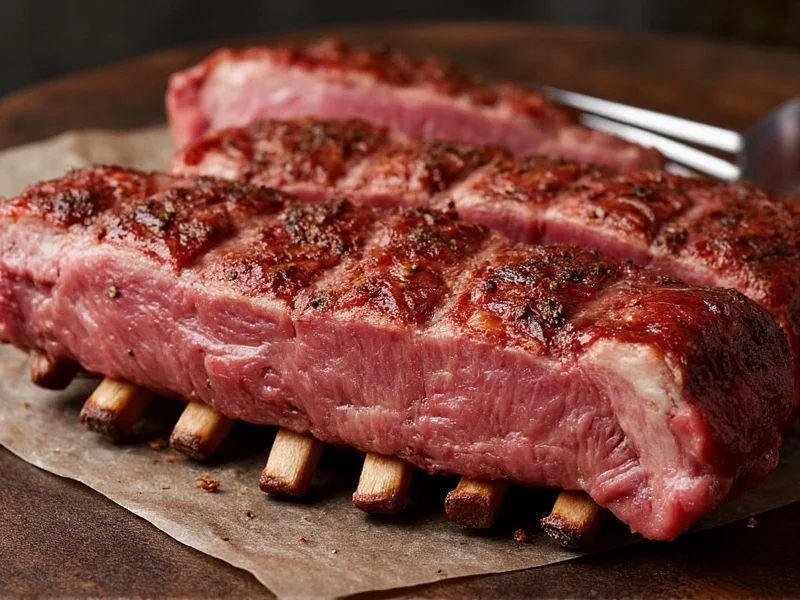When choosing between beef back ribs and beef short ribs, understanding their fundamental differences is crucial for achieving the best culinary results. These two popular cuts serve distinct purposes in the kitchen and deliver unique eating experiences based on their anatomical origins and physical characteristics.
Anatomical Origins and Physical Characteristics
Beef back ribs, also known as " loin back ribs" or "rib racks," come from the upper portion of the rib cage, specifically between the 6th and 12th ribs near the spine. These ribs feature longer bones with substantial meat between them, typically weighing 1.5-2.5 pounds per rack. The meat composition is relatively lean with moderate marbling, making them visually appealing with a higher meat-to-bone ratio.
Beef short ribs, conversely, originate from the lower portion of the rib cage near the belly, specifically from the 1st through 5th or 6th ribs. These cuts feature shorter bones with significant marbling and connective tissue. Short ribs typically come in three main styles: flanken cut (thin, across the bone), English cut (parallel to the bone), and boneless. Their distinctive feature is the rich intramuscular fat that melts during slow cooking, creating exceptionally tender results.
| Characteristic | Beef Back Ribs | Beef Short Ribs |
|---|---|---|
| Anatomical Location | Upper rib cage near spine (6th-12th ribs) | Lower rib cage near belly (1st-5th/6th ribs) |
| Bone Structure | Longer, straighter bones | Shorter, curved bones |
| Meat Composition | Leaner with moderate marbling | Rich marbling with significant connective tissue |
| Meat-to-Bone Ratio | Higher (more meat per bone) | Lower (more bone relative to meat) |
| Typical Weight | 1.5-2.5 lbs per rack | 1.5-3 lbs per serving |
Cooking Methods and Flavor Profiles
The optimal cooking approach differs significantly between these two cuts due to their structural composition. Beef back ribs respond exceptionally well to dry-heat methods like smoking, grilling, or roasting. Their relatively lean composition requires careful temperature control to prevent drying out, typically cooked at 225-250°F for 3-5 hours using the 3-2-1 method (3 hours unwrapped, 2 hours wrapped, 1 hour unwrapped with sauce). The resulting flavor profile is mild, beefy, with subtle sweetness when properly seasoned.
Beef short ribs demand slow, moist cooking methods to break down their abundant connective tissue. Braising, slow roasting, or pressure cooking transforms these initially tough cuts into meltingly tender morsels. The ideal cooking temperature ranges from 275-300°F for 3-4 hours, or lower temperatures for extended periods. This process renders the substantial marbling, creating a rich, deeply beefy flavor with unctuous texture that's impossible to achieve with back ribs.
Practical Selection Guide
Choosing between beef back ribs vs beef short ribs depends on your cooking timeline, equipment, and desired outcome. For backyard barbecue enthusiasts with access to a smoker or grill, beef back ribs provide that classic "fall-off-the-bone" experience with less cooking time. They're ideal when serving multiple guests since racks present well and offer more meat per serving.
Beef short ribs shine when you have time for slow cooking and seek maximum flavor intensity. They're perfect for special occasions where you want to impress with fork-tender meat that practically dissolves in your mouth. The difference between beef back ribs and short ribs becomes most apparent when considering your available cooking time—short ribs require patience but reward with unparalleled richness.
Price considerations also factor into the beef back ribs vs short ribs decision. Back ribs typically cost $5-8 per pound, while short ribs range from $7-12 per pound due to their superior marbling and demand. However, short ribs often provide better value when considering flavor concentration per serving.
Common Misconceptions Clarified
Many home cooks confuse beef short ribs with pork spare ribs, but they're entirely different cuts from different animals. Another frequent misunderstanding involves cooking times—while both benefit from low-and-slow methods, short ribs require significantly longer cooking to achieve tenderness due to their connective tissue content.
When shopping for these cuts, look for bright red meat with creamy white fat. For beef back ribs, check that the membrane on the bone side is intact. For short ribs, ensure consistent thickness across the cut for even cooking. Understanding how to identify beef short ribs versus back ribs prevents purchasing mistakes at the butcher counter.
Recipe Recommendations
For beef back ribs, try a classic dry rub with paprika, brown sugar, garlic powder, and cumin, followed by smoking with hickory or applewood. Finish with a light glaze of apple cider vinegar and honey for that perfect balance of sweet and tangy.
Beef short ribs excel in Korean galbi (marinated in soy, sesame, and pear), French-style bourguignon, or simple red wine braises. The key difference between beef back ribs and short ribs recipes lies in liquid content—short rib recipes require ample braising liquid, while back ribs thrive with minimal moisture.











 浙公网安备
33010002000092号
浙公网安备
33010002000092号 浙B2-20120091-4
浙B2-20120091-4